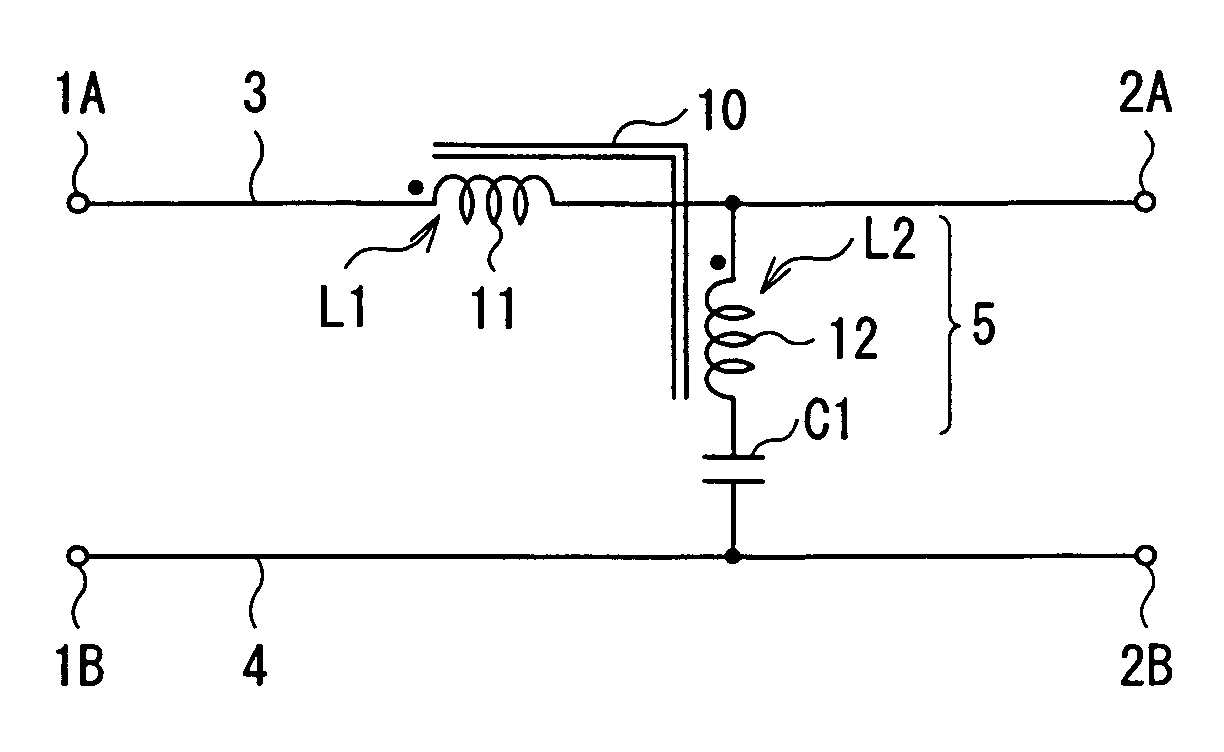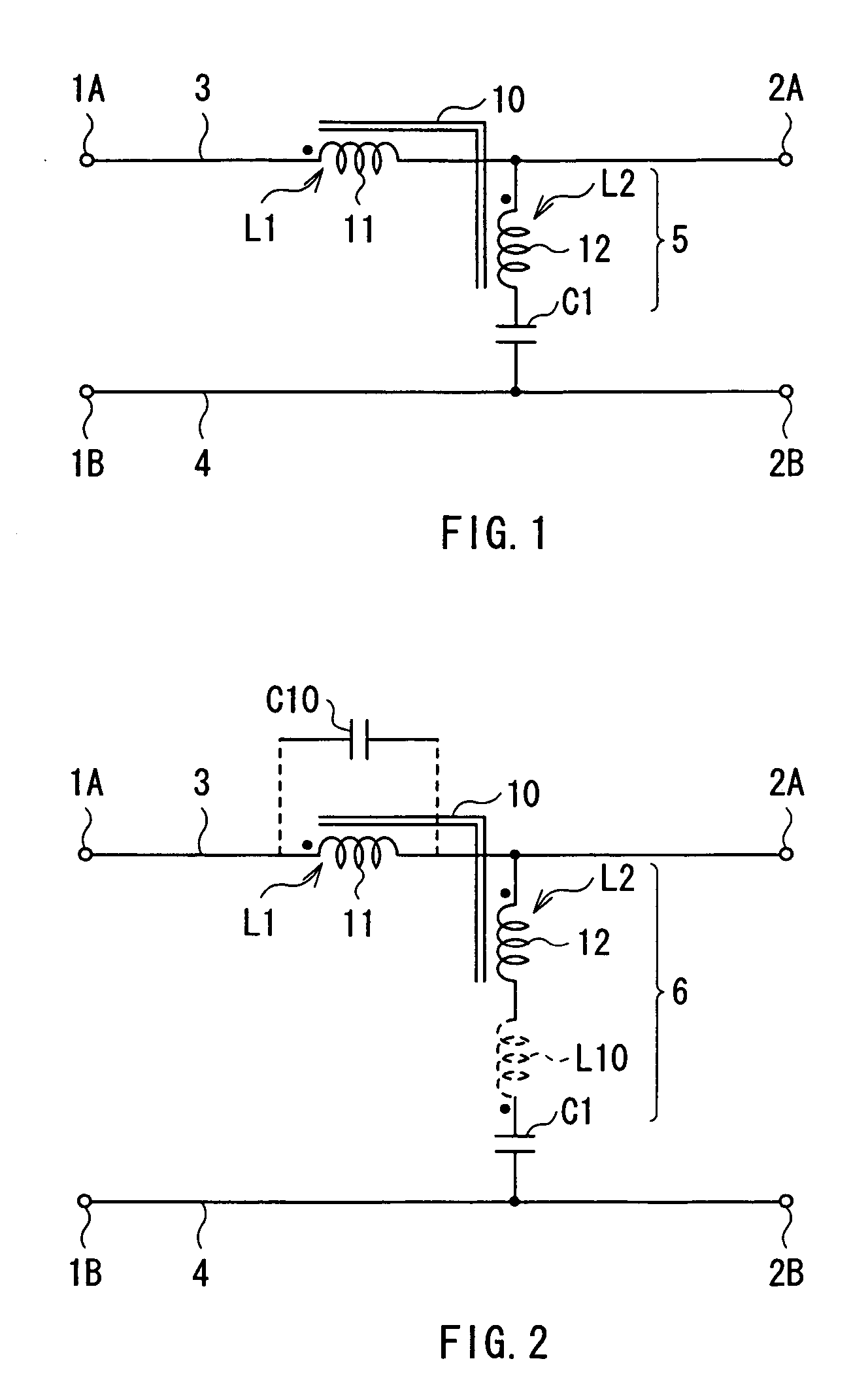Noise suppressor
a noise suppressor and noise technology, applied in the direction of overvoltage protection resistors, emergency protective arrangements for limiting excess voltage/current, conversion with intermediate conversion to dc, etc., can solve the problem of difficult to move the self-resonant point to a higher frequency side, adversely affecting high-pass performance at a self-resonant frequency or higher, and affecting the attenuation characteristic of parasitic components. , to achieve the effect of preventing the degradation of parasi
- Summary
- Abstract
- Description
- Claims
- Application Information
AI Technical Summary
Benefits of technology
Problems solved by technology
Method used
Image
Examples
first embodiment
[0077] First, a noise suppressor according to a first embodiment of the invention will be described below. FIG. 1 shows an example of the noise suppressor according to the embodiment. The noise suppressor relates to a circuit for normal mode noise prevention.
[0078] The noise suppressor includes a pair of terminals 1A and 1B, another pair of terminals 2A and 2B, a first current-carrying wire 3 which establishes connection between the terminals 1A and 2A, and a second current-carrying wire 4 which establishes connection between the terminals 1B and 2B. The noise suppressor further includes a first winding wire 11 disposed on the first current-carrying wire 3, and a series circuit 5 having one end connected to the first current-carrying wire 3 and the other end connected to the second current-carrying wire 4. The series circuit 5 includes a capacitor C1 and a second winding wire 12 which are connected to each other in series. One end of the second winding wire 12 is connected to the f...
second embodiment
[0101] Next, a noise suppressor according to a second embodiment of the invention will be described below.
[0102] In the noise suppressor according to the above-described first embodiment, as one condition, the inductance xL of the whole second winding wire 12 is equal to or smaller than the inductance LL1 per turn in the first winding wire 11. Moreover, magnetic coupling between the first winding wire 11 and the second winding wire 12 is preferably strong (ideally, the coupling coefficient k1≈1). However, in the case of the structure in which the first winding wire 11 and the second winding wire 12 are magnetically coupled directly to each other via the common core 10, it is difficult to satisfy the condition of xL≦LL1, and for the inductance xL to be smaller than the inductance LL1 per turn while magnetic coupling between the first winding wire 11 and the second winding wire 12 is kept strong.
[0103] For example, as shown in FIG. 10, when the second winding wire 12 is wound so tha...
third embodiment
[0112] Next, a noise suppressor according to a third embodiment of the invention will be described below.
[0113]FIG. 14 shows an example of the noise suppressor according to the embodiment. The embodiment relates to a circuit for common mode noise prevention. In the embodiment, like components are denoted by like numerals as of the noise suppressor according to the first and the second embodiments and will not be further described.
[0114] The noise suppressor includes the first winding wire 11 disposed on the first current-carrying-wire 3 and a first series circuit 5-1 having one end connected to the first current-carrying wire 3 and the other end connected to ground. The first series circuit 5-1 includes the first capacitor C1 and the second winding wire 12 which are connected to each other in series. One end of the second winding wire 12 is connected to the first current-carrying wire 3, and the other end of the second winding wire 12 is connected to one end of the first capacitor...
PUM
 Login to View More
Login to View More Abstract
Description
Claims
Application Information
 Login to View More
Login to View More - R&D
- Intellectual Property
- Life Sciences
- Materials
- Tech Scout
- Unparalleled Data Quality
- Higher Quality Content
- 60% Fewer Hallucinations
Browse by: Latest US Patents, China's latest patents, Technical Efficacy Thesaurus, Application Domain, Technology Topic, Popular Technical Reports.
© 2025 PatSnap. All rights reserved.Legal|Privacy policy|Modern Slavery Act Transparency Statement|Sitemap|About US| Contact US: help@patsnap.com



